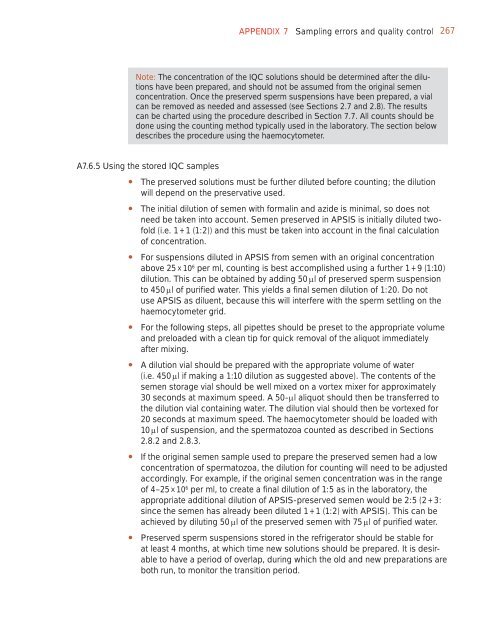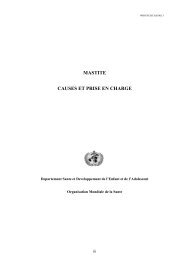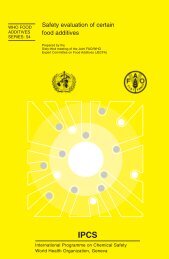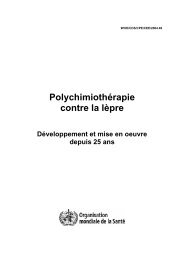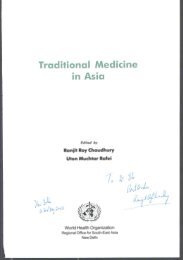Examination and processing of human semen - libdoc.who.int ...
Examination and processing of human semen - libdoc.who.int ...
Examination and processing of human semen - libdoc.who.int ...
Create successful ePaper yourself
Turn your PDF publications into a flip-book with our unique Google optimized e-Paper software.
APPENDIX 7 Sampling errors <strong>and</strong> quality control<br />
267<br />
Note: The concentration <strong>of</strong> the IQC solutions should be determined after the dilutions<br />
have been prepared, <strong>and</strong> should not be assumed from the original <strong>semen</strong><br />
concentration. Once the preserved sperm suspensions have been prepared, a vial<br />
can be removed as needed <strong>and</strong> assessed (see Sections 2.7 <strong>and</strong> 2.8). The results<br />
can be charted using the procedure described in Section 7.7. All counts should be<br />
done using the counting method typically used in the laboratory. The section below<br />
describes the procedure using the haemocytometer.<br />
A7.6.5 Using the stored IQC samples<br />
<br />
<br />
<br />
<br />
<br />
<br />
<br />
The preserved solutions must be further diluted before counting; the dilution<br />
will depend on the preservative used.<br />
The initial dilution <strong>of</strong> <strong>semen</strong> with formalin <strong>and</strong> azide is minimal, so does not<br />
need be taken <strong>int</strong>o account. Semen preserved in APSIS is initially diluted tw<strong>of</strong>old<br />
(i.e. 1 + 1 (1:2)) <strong>and</strong> this must be taken <strong>int</strong>o account in the final calculation<br />
<strong>of</strong> concentration.<br />
For suspensions diluted in APSIS from <strong>semen</strong> with an original concentration<br />
above 25 × 10 6 per ml, counting is best accomplished using a further 1 + 9 (1:10)<br />
dilution. This can be obtained by adding 50 l <strong>of</strong> preserved sperm suspension<br />
to 450 l <strong>of</strong> purified water. This yields a final <strong>semen</strong> dilution <strong>of</strong> 1:20. Do not<br />
use APSIS as diluent, because this will <strong>int</strong>erfere with the sperm settling on the<br />
haemocytometer grid.<br />
For the following steps, all pipettes should be preset to the appropriate volume<br />
<strong>and</strong> preloaded with a clean tip for quick removal <strong>of</strong> the aliquot immediately<br />
after mixing.<br />
A dilution vial should be prepared with the appropriate volume <strong>of</strong> water<br />
(i.e. 450 l if making a 1:10 dilution as suggested above). The contents <strong>of</strong> the<br />
<strong>semen</strong> storage vial should be well mixed on a vortex mixer for approximately<br />
30 seconds at maximum speed. A 50-l aliquot should then be transferred to<br />
the dilution vial containing water. The dilution vial should then be vortexed for<br />
20 seconds at maximum speed. The haemocytometer should be loaded with<br />
10 l <strong>of</strong> suspension, <strong>and</strong> the spermatozoa counted as described in Sections<br />
2.8.2 <strong>and</strong> 2.8.3.<br />
If the original <strong>semen</strong> sample used to prepare the preserved <strong>semen</strong> had a low<br />
concentration <strong>of</strong> spermatozoa, the dilution for counting will need to be adjusted<br />
accordingly. For example, if the original <strong>semen</strong> concentration was in the range<br />
<strong>of</strong> 4–25 × 10 6 per ml, to create a final dilution <strong>of</strong> 1:5 as in the laboratory, the<br />
appropriate additional dilution <strong>of</strong> APSIS-preserved <strong>semen</strong> would be 2:5 (2 + 3:<br />
since the <strong>semen</strong> has already been diluted 1 + 1 (1:2) with APSIS). This can be<br />
achieved by diluting 50 l <strong>of</strong> the preserved <strong>semen</strong> with 75 l <strong>of</strong> purified water.<br />
Preserved sperm suspensions stored in the refrigerator should be stable for<br />
at least 4 months, at which time new solutions should be prepared. It is desirable<br />
to have a period <strong>of</strong> overlap, during which the old <strong>and</strong> new preparations are<br />
both run, to monitor the transition period.


